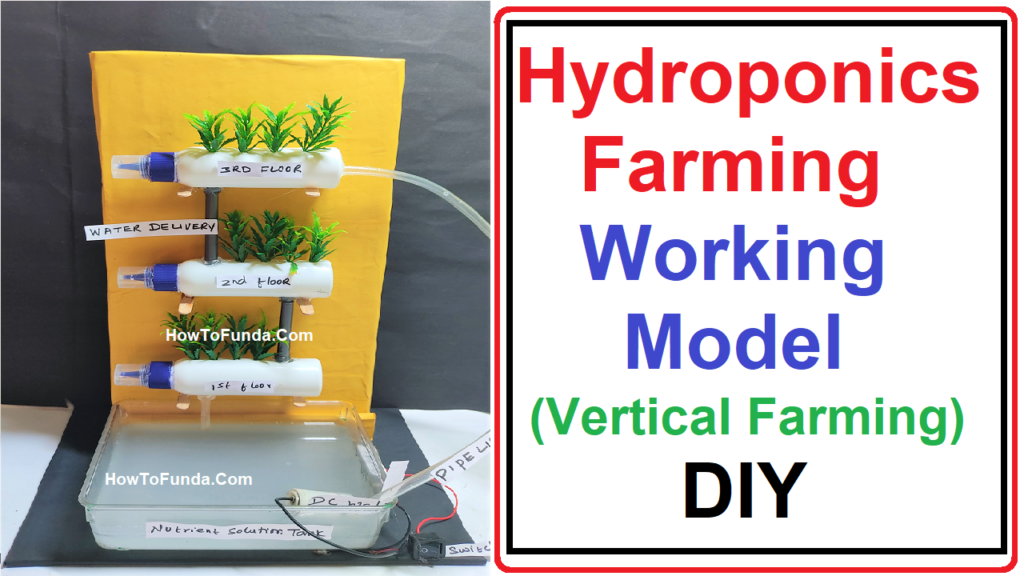Food security is a concept that goes beyond the simple availability of food; it encompasses the accessibility, utilization, and stability of food sources that contribute to the overall well-being of individuals and communities.
In simpler terms, food security ensures that all people, at all times, have physical, social, and economic access to sufficient, safe, and nutritious food to meet their dietary needs and food preferences for an active and healthy life.
Creating a science exhibition working model on food security involves highlighting the importance of sustainable agriculture, efficient food distribution, and the need for innovative solutions to address global hunger.
Here’s a simple working model idea that you can use:

Materials Needed:
- Large, transparent plastic container or fish tank
- Styrofoam or foam board
- Plastic cups or net pots
- Hydroponic nutrient solution
- Small plants or seeds
- LED grow lights (optional)
- Water pump
- Tubing for water circulation
- Thermometer
- pH testing kit
- Marker
- Cardboard or display board
- Craft supplies for labeling and decoration
Step by Step video Instructions:
1. Setting Up the Hydroponic System:
- Cut holes into the styrofoam or foam board to hold the plastic cups or net pots.
- Fill the plastic container with the hydroponic nutrient solution.
- Place the styrofoam board over the container, ensuring that the cups or net pots are submerged in the nutrient solution.
2. Planting Seeds or Seedlings:
- Plant small vegetables or herbs in the cups or net pots. These could include lettuce, herbs, or small vegetables suitable for hydroponic systems.
3. Water Circulation:
- Set up a water pump connected to tubing to circulate the nutrient solution through the cups, providing the plants with essential nutrients.
4. Monitoring Conditions:
- Use a thermometer to monitor the temperature of the nutrient solution.
- Use a pH testing kit to check and maintain the pH levels of the nutrient solution.
5. Optional: LED Grow Lights:
- If the exhibition is held indoors or in a location with limited natural light, you can incorporate LED grow lights above the hydroponic system to simulate sunlight.
6. Display Board:
- Create a display board or cardboard backdrop to explain the hydroponic system and its role in ensuring food security.
- Include information on how hydroponics conserves water, maximizes crop yield, and minimizes the use of pesticides.
7. Interactive Component:
- Add an interactive element where visitors can observe and understand the hydroponic system in action.
- Provide information on how hydroponics contributes to sustainable agriculture and food security.
8. Labeling:
- Label each component of the model, explaining its function and contribution to sustainable food production.
9. Educational Messaging:
- Use charts, graphs, or infographics to convey data on traditional farming methods compared to hydroponic systems in terms of resource efficiency.
10. Q&A Section:
- Designate an area for questions and answers, allowing visitors to engage and learn more about the significance of sustainable agriculture for food security.
Educational Aspects:
- Sustainable Agriculture: Highlight how hydroponic systems contribute to sustainable agriculture by using less water, reducing the need for arable land, and minimizing environmental impact.
- Year-Round Crop Production: Emphasize the advantage of hydroponic systems in providing year-round crop production, irrespective of seasonal variations.
- Reduced Dependency on Soil: Explain how hydroponics eliminates the dependency on soil, making it feasible for urban areas or regions with poor soil quality.
- Resource Efficiency: Illustrate how hydroponics maximizes resource efficiency, conserving water and nutrients while reducing the use of pesticides.
- Addressing Food Security Issues: Connect the model to broader discussions on global food security issues, emphasizing the potential of innovative farming methods to address these challenges.
Remember to tailor the complexity of the model and accompanying information based on the target audience’s age and understanding. The goal is to inspire curiosity and raise awareness about the role of sustainable agriculture in ensuring food security for a growing global population.

